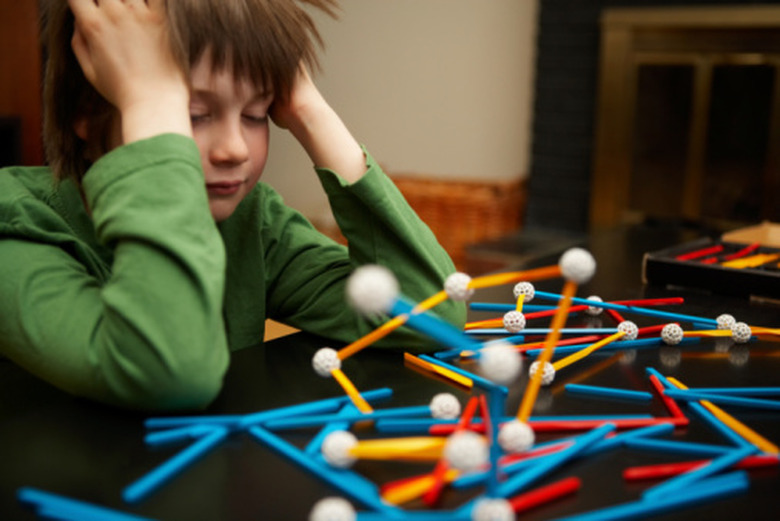Easy Science Projects For Second Grade
Science projects for second grade students should be simple enough that the students can do them, yet challenge them at the same time to use the skills they've learned. The elements in the project should not be complicated; in fact, you probably already have many of the items in your own household. If not, make a quick and inexpensive trip to the drugstore or craft store to purchase the necessary items.
Rock Candy
Rock Candy
The ability to apply science to something you can consume is a way to build excitement in your second grade students. After all, cooking is a science. Making rock candy as a science fair project with your second graders is educational and enjoyable. Provide the children with wooden skewers, a clothespin, 1 cup of water, 2 to 3 cups of sugar and a tall glass. Place the clothespin on the skewer about halfway down, so that the clothespin will stop the skewer from sliding. Under close adult supervision, the second graders can bring the water to a boil, and slowly add all of the sugar until it dissolves. Remove it from the heat and then let the mixture cool for at least 20 minutes. Pour the mixture back into the glass and put the skewer into the glass. In three to seven days, the kids have made their own rock candy. The longer you wait, the more crystals you have. For the science fair, make a few batches so that your second graders can show the development of the crystals in different stages. Mixing water and sugar is a super-saturated solution, which means that the water can only hold the sugar if it's hot. When the water cools, the sugar separates and starts to go back to its original form, hence the crystals.
Lift an Ice Cube With Salt
Lift an Ice Cube With Salt
A safe scientific magic trick for second graders is learning how to lift an ice cube out of water. Have the children use ice cubes, cold water, glass, salt and a piece of sewing thread or floss. Put an ice cube in the water and take the string and lay it across the ice cube. Take the salt and sprinkle it on top of the string and wait one to two minutes. Take the ends of the string and pull it out of the water. The salt melts the ice cube around and under the thread just enough since salt has a lower melting point than water alone. As the salt dilutes more, the melting point rises closer to that of pure water. When that happens, the ice and cold water cools the water around the thread and refreezes it, allowing you to pull the ice cube out of the water. You may need to assist the kids with this part of the step.
Explaining Why the Sky Is Blue
Explaining Why the Sky Is Blue
A question that you may have, whether young or old, is why is the sky blue. With this easy science project, your second grader can soon provide an answer. Have your second grader use a mirror, a piece of white paper, water, a large shallow pan and direct sunlight. Fill the pan with 2/3s water, and place it in direct sunlight. Hold the mirror under the pan, with the white paper held above the pan. Explain that this experiment reveals the prism color spectrum, which is called "Rayleigh scattering." Light scatters when it goes through particles that have a diameter approximately 1/10th of the wavelength, or color, of the light. Sunlight is made up of different colors of light, but with the elements in the atmosphere, the color blue scatters more efficiently. If you can't get outside for the project, take pictures or a video of the experiment to demonstrate it.
Pop Rocks Science
Pop Rocks Science
Pop Rocks are candy packed with science waiting to be unloaded. For this experiment, have the second graders use a packet of Pop Rocks, a 12- to 16-oz. bottle of soda, a balloon and a narrow-mouthed jar. Help the children pour the package of Pop Rocks into a balloon. Open the bottle of soda and attach the balloon. Lift up the balloon and let all the Pop Rocks fall into the soda. Explain that the balloon does not inflate very much because Pop Rocks are made with sugar, lactose, corn syrup and flavoring. These ingredients are heated to their boiling points, and the hot sugar mixture is mixed with carbon dioxide gas under high pressure. This causes small high pressure bubbles of carbon dioxide gas to form inside the candy. After this mixture cools and the gas pressure is released, the candy will shatter into little pieces of candy with carbonation. Tell the kids that as the candy melts in your mouth, the bubbles of gas are released, complete with the famous popping sound. The balloon shows that mixing Pop Rocks with soda is a physical reaction, rather than a chemical reaction.
Cite This Article
MLA
Cooksey, Alison. "Easy Science Projects For Second Grade" sciencing.com, https://www.sciencing.com/easy-science-projects-second-grade-8013585/. 24 April 2017.
APA
Cooksey, Alison. (2017, April 24). Easy Science Projects For Second Grade. sciencing.com. Retrieved from https://www.sciencing.com/easy-science-projects-second-grade-8013585/
Chicago
Cooksey, Alison. Easy Science Projects For Second Grade last modified August 30, 2022. https://www.sciencing.com/easy-science-projects-second-grade-8013585/
